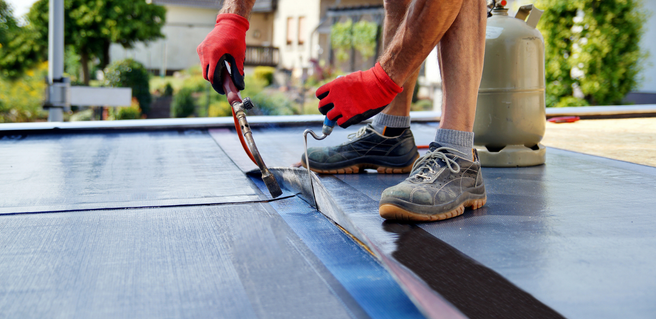A flat roofing system is a popular choice for commercial buildings, especially in retail and office spaces. Instead of traditional sloped panels, a flat roof is, as the name suggests, generally level. However, this can lead to problems with water pooling on the surface. To prevent this, flat roof drainage uses tapered insulation to gradually slope the roof towards a roof drain or scupper, where excess water can be directed into a gutter system. This simple setup helps to manage water and minimize the risk of leaks or damage to the roof structure. While not as visually appealing as a sloped roof, flat roofing systems are a functional and cost-effective option for many commercial buildings.
Benefits of a Flat Roofing System
While traditional sloped roofing systems may be the more common choice, flat roofing systems offer a range of benefits for both residential and commercial properties. One major advantage is energy efficiency. Flat roofs are able to better retain heat in the winter, and reflect sunlight in the summer, helping to regulate indoor temperatures and lower energy costs. Flat roofs also tend to be easier to clean and maintain since they provide a smooth surface that can be easily accessed for repairs or upkeep. Additionally, flat roofs are often easier to install, saving time and money during construction or renovation. Overall, flat roofing systems may not be right for every property, but their energy efficiency and ease of maintenance make them a strong option worth considering.
The Different Types of Flat Roofing Systems
When it comes to flat roofing systems, there are a variety of options for homeowners and businesses to choose from. The built-up roof, also known as a tar and gravel roof, is one of the oldest options and consists of layers of tar and reinforcement materials such as fiberglass or felt. Modified bitumen roofs are similar, but use rubberized asphalt instead of tar. Thermoplastic Polyolefin (TPO) and Polyvinyl Chloride (PVC) roofs are made from durable synthetic materials, while fluid-applied roofs involve spraying on a liquid material that dries into a waterproof barrier. Each type has its own advantages and drawbacks, so it’s important to do your research and work with an experienced roofer to ensure you select the best option for your specific needs.
Maintain your Flat Roofing System
Keeping your flat roofing system in good shape means regularly clearing it of debris, cleaning the membrane, and repairing any damage that may occur. This can often be done safely with a broom or leaf blower. However, it is important to also inspect the roof regularly for any cracks or holes in the membrane. These should be repaired as soon as possible to prevent water leaks and further damage to the roof. The membrane can also become contaminated with dirt and algae over time, but this can be cleaned using a mild detergent and a pressure washer. Proper maintenance of your flat roof will not only extend its lifespan but also ensure that it remains functional and protects your home from outside elements.
Common Flat Roofing System Problems & How to Fix Them
Flat roofs may seem like a cost-effective option for commercial buildings, but they can come with their own set of challenges. One of the most common problems is ponding on a flat roof, which occurs when water accumulates and pools on the roof instead of draining properly. In addition to causing leaks, ponding can also lead to excessive wear and tear on the roof’s surface. Regular maintenance is key to prevent ponding – make sure drains are clear and in good working condition, and consider installing a sloped structure to encourage proper drainage. Another issue that often plagues flat roofs is debris buildup, particularly in areas with heavy tree coverage. Leaves and branches can clog drains and traps; it’s important to regularly clean out these components as part of your maintenance routine. By addressing these potential issues early on, you can help prolong the life of your flat roof and prevent costly repairs down the line.
Flat Roofing Systems FAQs
One common question about flat roofing systems is how they drain. The answer is that flat roofs often have a slight angle, or slope, to aid in drainage. They also typically have an internal drainage system made up of gutters and downspouts. In some cases, a rooftop pump may be necessary to remove standing water. While some minor pooling can occur during heavy rainstorms, it is not normal for consistent ponding to happen on a flat roof. This can indicate an issue with the drainage system and should be addressed as soon as possible. To maintain a flat roof and prevent issues like ponding, it is important to regularly clean the gutters and check for any cracks or leaks in the roof surface. Scheduling professional inspections every few years can also help identify potential problems early on before they become costly to fix. Overall, following these tips and discussing any concerns with your roofing contractor can ensure that your flat roof remains in good condition for years to come.
Conclusion
Flat roofing systems are becoming an increasingly popular choice for homeowners and businesses alike. They offer a number of benefits, such as durability, flexibility, and energy efficiency. There are a variety of flat roofing systems available on the market today, so it’s important to choose one that will fit your specific needs. In order to get the most out of your flat roofing system, it’s important to keep it well-maintained. If you encounter any problems with your roof, there are several solutions available. For more information about flat roofing systems or to find a qualified roofer in your area, please visit our website or call us today.
Colony Roofers
https://colonyroofers.com
715 Peachtree St NE Suite 100
Atlanta, GA 30308
678-365-3138
